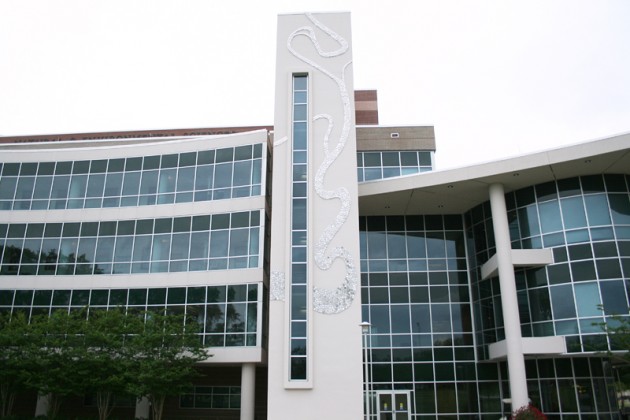Building’s artwork depicts river flow

An array of stainless steel disks suspended on the wall of the Natural and Environmental Science (NES) building maps out the path of the Hillsborough River through the USF Tampa campus.
A concept four to five years in the making, the piece, titled “Tampa Wind,” was created by artist Stacy Levy. A committee of USF faculty members selected Levy to create the piece.
“There was a national search for artists capable of doing a project that would have a concept related to natural science,” said Vince Ahern, director of public art at the Contemporary Art Museum.
Ahern said when Levy visited USF, she noticed the significance of the Hillsborough River as a natural environment around the University, and the concept of the work was born.
“It became a point of departure (for the piece),” he said.
Constructed completely of stainless steel, the river is made up of a back plate, variously sized disks and “risers” that hold the disks in place and allow them to flow with the wind.
The shiny disks also reflect the surrounding environment, Ahern said.
“Stacy Levy’s ‘Tampa Water’ is a drawing of the Hillsborough River as it passes through the USF campus,” Ahern said. “It functions in real time to present both the wind and light conditions of the site, poetically becoming both a ‘river of wind’ and a ‘river of light.'”
The piece had to be “registered” on the front wall of the building before it was placed, going from paper to masonite to stainless steel — a process that took place last week. Ahern said the final project was complete Friday.
“Even as it was going up, comments were positive,” he said.
He said that over a number of years, both the committee and USF President Judy Genshaft approved the design.
The piece was part of the original budget for the NES building from its beginning, said NES building manger Robert Brinkmann.
Ahern said the funds for the project came from Florida’s Art in State Buildings program, which mandates that one-half percent of state funds for a public building must be set aside for art.
The committee involved in the process included John Pehling of Reynolds, Smith and Hills, the architect for the building, and James Garey, professor and chairman of the Department of Biology. Other members were drawn from the Contemporary Art Museum including Ahern, Don Fuller, the new media curator, and Tony Palms, the coordinator of exhibitions.





